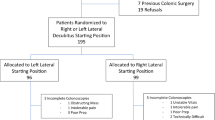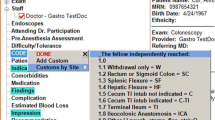Abstract
Background/Aim
Cecal intubation using conventional colonoscopy (CC) requires substantial training. We hypothesized that double-balloon colonoscopy (DBC) facilitates cecal intubation by endoscopy naïve operators. The aim of this study is to evaluate the cecal intubation rate and learning curve of DBC compared with CC.
Methods
Eighteen endoscopy naïve medical students were allocated to two groups and attempted cecal intubation within 20 min using a colon simulator. In group A, CC was performed ten times and then DBC ten times. In group B, the reverse was carried out. We evaluated the cecal intubation rate and learning curve.
Results
The overall success rate for cecal intubation using DBC was significantly superior to CC [132/180 (73%) vs. 12/180 (7%), p < 0.001]. To evaluate the success rate overtime, we divided the ten repetitions of the procedure into three time periods: first (1–3), second (4–6), and third (7–10). The success rate using CC is <20%, even during the third time period, in both groups, and one perforation occurred. The success rate using DBC is over 30% in the first period and increased to nearly 80% in the third period in both groups. Finally, we evaluated the time needed for cecal intubation using DBC. The mean cecal intubation time in the first period is 14 min and decreased to 11 min in the third period.
Conclusions
DBC has a higher cecal intubation rate than CC performed by endoscopy naïve medical students using a colon simulator in this randomized-controlled, cross-over study.





Similar content being viewed by others
References
Guidelines for credentialing and granting privileges for gastrointestinal endoscopy. American Society for Gastrointestinal Endoscopy. Gastrointest Endosc. 1998;48:679–682.
Koido S, Ohkusa T, Nakae K, et al. Factors associated with incomplete colonoscopy at a Japanese academic hospital. World J Gastroenterol. 2014;20:6961–6967.
Yamamoto H, Sekine Y, Sato Y, et al. Total enteroscopy with a nonsurgical steerable double-balloon method. Gastrointest Endosc. 2001;53:216–220.
Hotta K, Katsuki S, Ohata K, et al. A multicenter, prospective trial of total colonoscopy using a short double-balloon endoscope in patients with previous incomplete colonoscopy. Gastrointest Endosc. 2012;75:813–818.
Plooy AM, Hill A, Horswill MS, et al. Construct validation of a physical model colonoscopy simulator. Gastrointest Endosc. 2012;76:144–150.
Vargo JJ. North of 100 and south of 500: where does the “sweet spot” of colonoscopic competence lie? Gastrointest Endosc. 2010;71:325–326.
Zauber AG, Winawer SJ, O’Brien MJ, et al. Colonoscopic polypectomy and long-term prevention of colorectal-cancer deaths. N Engl J Med. 2012;366:687–696.
Spier BJ, Benson M, Pfau PR, Nelligan G, Lucey MR, Gaumnitz EA. Colonoscopy training in gastroenterology fellowships: determining competence. Gastrointest Endosc. 2010;71:319–324.
Wilkins T, LeClair B, Smolkin M, et al. Screening colonoscopies by primary care physicians: a meta-analysis. Ann Fam Med. 2009;7:56–62.
Dzeletovic I, Harrison ME, Pasha SF, et al. Comparison of single- versus double-balloon assisted-colonoscopy for colon examination after previous incomplete standard colonoscopy. Dig Dis Sci. 2012;57:2680–2686.
Nemoto D, Isohata N, Utano K, Hewett DG, Togashi K. Double-balloon colonoscopy carried out by a trainee after incomplete conventional colonoscopy. Dig Endosc. 2014;26:392–395.
Author information
Authors and Affiliations
Corresponding author
Ethics declarations
Conflict of interest
H.Y. has a consultant relationship with FUJIFILM Corporation and has received Honoraria, Grants, and Royalties from the company. He has patents for the double-balloon endoscope produced by FUJIFILM Corporation. Y.H. has received Honoraria from FUJIFILM Corporation. The funding source had no role in the design, practice, or analysis of this study. All other authors do not have any conflict of interests.
Rights and permissions
About this article
Cite this article
Sunada, K., Shinozaki, S., Yano, T. et al. Double-Balloon Colonoscopy Has a Higher Cecal Intubation Rate Than Conventional Colonoscopy Using a Colon Simulator. Dig Dis Sci 62, 979–983 (2017). https://doi.org/10.1007/s10620-017-4477-2
Received:
Accepted:
Published:
Issue Date:
DOI: https://doi.org/10.1007/s10620-017-4477-2




